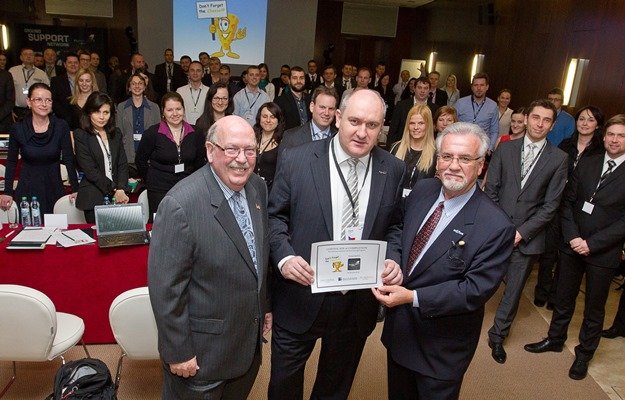Great Customer Service. The Universal Language Spoken Everywhere.
/ John Enticknap, Charlie Bodnar and Ron Jackson with Euro Jet agents in Prague
John Enticknap, Charlie Bodnar and Ron Jackson with Euro Jet agents in Prague
By John L. Enticknap and Ron R. Jackson
Aviation Business Strategies Group
Recently we were approached by Charlie Bodnar, the CEO of Euro Jet, to see if we might be interested in teaching our Don’t Forget the Cheese!© FBO customer service training program at their Global Network Forum scheduled for January in Prague. Euro Jet is a leading international provider of both flight and ground support services.
 At first, we were a little concerned our Americanized content would possibly lose some meaning half way around the world in a very different culture. However, our fears were quickly erased as Charlie explained that more than 60 percent of Euro Jet’s customers were U.S. based flight crews.
At first, we were a little concerned our Americanized content would possibly lose some meaning half way around the world in a very different culture. However, our fears were quickly erased as Charlie explained that more than 60 percent of Euro Jet’s customers were U.S. based flight crews.
“It may sound crazy teaching our people American service standards,” Charlie asserted when we met in October at the Annual NBAA meeting in Orlando. “But this market is very important to us and we want to make sure we meet our customer’s expectations.”
So on Jan. 12 we packed our bags and headed to Prague. We were still a little unsure if we would be able to adequately communicate the principles of our program that’s been popular in various parts of the good old U.S. of A. but had never stood the international test on the other side of the pond.
Upon arrival, we met with Zaneta Balochova who handles marketing at Euro Jet. She was quick to put us at ease as we were given a preview of the room in which we would be teaching at the historic Boscolo Hotel near Prague’s Old Town. As the agents began to filter into the room, we started to chit chat a little and practiced pronouncing their names.
There was Ulrika from Estonia, Marian from Bulgaria, Eugenijus from Lithuania and Robert from Macedonia, among many others. We were immediately impressed by their command of the English language, although not altogether surprising since English is spoken throughout the international aviation community. Still, the little nuances that started to creep into our mini conversations gave us encouragement that we would be understood well beyond the basics.
What was most interesting is how these agents, some 70 of them from 20 countries in Europe and Asia, learned to speak English. Several we talked to said they watched and studied subtitled American movies, repeatedly, practicing the English dialogue over and over again. Now that’s dedication!
However, the universal language that brought us all together was customer service. Here we found middle ground, striking a common chord that resonated throughout the entire room.
The agents quickly understood that the objective of providing excellent customer service was to gain a long-term, profitable customer relationship. Just as we teach in our NATA FBO Success Seminar, they promptly recognized that the surest way to differentiate their brand from the competition was by offering a great customer service experience.
They also embraced enthusiastically the true test of whether a great customer service experience was achieved by asking one simple question of the customer upon departure: “Would you recommend us?”
We can tell you, unequivocally, that we would recommend the good folks at Euro Jet … in a heartbeat. Not because we were their guests and taught them the American way. Rather, and most importantly, it’s because they got it. They intuitively understood that providing great customer service is a universal language, appreciated and understood by loyal customers anywhere in the world.
For a compelling Euro Jet perspective of our training experience in Prague, we invite to read a companion blog written by Gareth Danker, Director of Global Sales and Marketing. Please click here for content.
About the bloggers:
John Enticknap has more than 35 years of aviation fueling and FBO services industry experience. Ron Jackson is co-founder of Aviation Business Strategies Group and president of The Jackson Group, a PR agency specializing in FBO marketing and customer service training. For more background, visit the biography page or www.absggroup.com.


